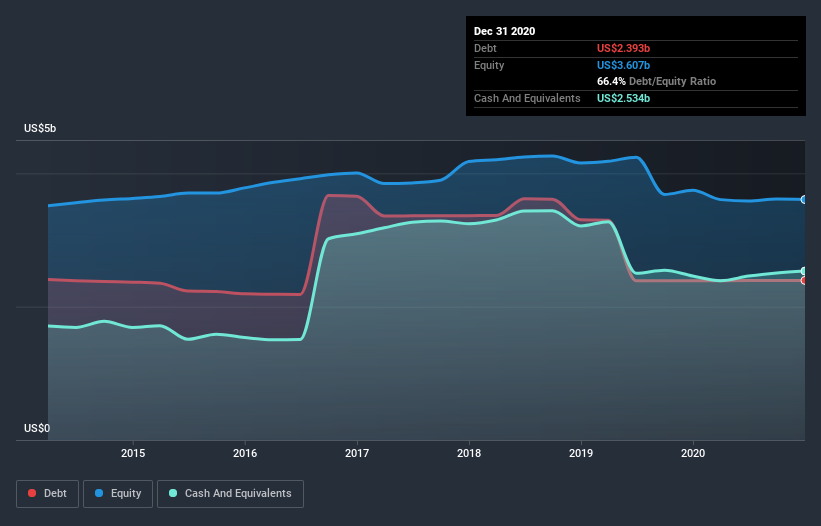We Think EchoStar (NASDAQ:SATS) Can Stay On Top Of Its Debt
Warren Buffett famously said, 'Volatility is far from synonymous with risk.' So it seems the smart money knows that debt - which is usually involved in bankruptcies - is a very important factor, when you assess how risky a company is. Importantly, EchoStar Corporation (NASDAQ:SATS) does carry debt. But the more important question is: how much risk is that debt creating?
What Risk Does Debt Bring?
Debt is a tool to help businesses grow, but if a business is incapable of paying off its lenders, then it exists at their mercy. Part and parcel of capitalism is the process of 'creative destruction' where failed businesses are mercilessly liquidated by their bankers. However, a more frequent (but still costly) occurrence is where a company must issue shares at bargain-basement prices, permanently diluting shareholders, just to shore up its balance sheet. Having said that, the most common situation is where a company manages its debt reasonably well - and to its own advantage. When we think about a company's use of debt, we first look at cash and debt together.
Check out our latest analysis for EchoStar
What Is EchoStar's Debt?
The chart below, which you can click on for greater detail, shows that EchoStar had US$2.38b in debt in December 2020; about the same as the year before. However, it does have US$2.53b in cash offsetting this, leading to net cash of US$155.3m.
A Look At EchoStar's Liabilities
We can see from the most recent balance sheet that EchoStar had liabilities of US$1.43b falling due within a year, and liabilities of US$2.04b due beyond that. Offsetting these obligations, it had cash of US$2.53b as well as receivables valued at US$184.0m due within 12 months. So its liabilities outweigh the sum of its cash and (near-term) receivables by US$747.8m.
This deficit isn't so bad because EchoStar is worth US$2.21b, and thus could probably raise enough capital to shore up its balance sheet, if the need arose. However, it is still worthwhile taking a close look at its ability to pay off debt. While it does have liabilities worth noting, EchoStar also has more cash than debt, so we're pretty confident it can manage its debt safely.
It is well worth noting that EchoStar's EBIT shot up like bamboo after rain, gaining 57% in the last twelve months. That'll make it easier to manage its debt. The balance sheet is clearly the area to focus on when you are analysing debt. But it is future earnings, more than anything, that will determine EchoStar's ability to maintain a healthy balance sheet going forward. So if you're focused on the future you can check out this free report showing analyst profit forecasts.
Finally, while the tax-man may adore accounting profits, lenders only accept cold hard cash. While EchoStar has net cash on its balance sheet, it's still worth taking a look at its ability to convert earnings before interest and tax (EBIT) to free cash flow, to help us understand how quickly it is building (or eroding) that cash balance. Over the last three years, EchoStar actually produced more free cash flow than EBIT. There's nothing better than incoming cash when it comes to staying in your lenders' good graces.
Summing up
While EchoStar does have more liabilities than liquid assets, it also has net cash of US$155.3m. The cherry on top was that in converted 142% of that EBIT to free cash flow, bringing in US$87m. So we are not troubled with EchoStar's debt use. The balance sheet is clearly the area to focus on when you are analysing debt. But ultimately, every company can contain risks that exist outside of the balance sheet. To that end, you should be aware of the 1 warning sign we've spotted with EchoStar .
At the end of the day, it's often better to focus on companies that are free from net debt. You can access our special list of such companies (all with a track record of profit growth). It's free.
This article by Simply Wall St is general in nature. It does not constitute a recommendation to buy or sell any stock, and does not take account of your objectives, or your financial situation. We aim to bring you long-term focused analysis driven by fundamental data. Note that our analysis may not factor in the latest price-sensitive company announcements or qualitative material. Simply Wall St has no position in any stocks mentioned.
Have feedback on this article? Concerned about the content? Get in touch with us directly. Alternatively, email editorial-team (at) simplywallst.com.

